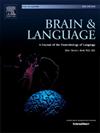Semantic memory structure mediates the role of brain functional connectivity in creative writing
IF 2.3
2区 心理学
Q1 AUDIOLOGY & SPEECH-LANGUAGE PATHOLOGY
引用次数: 0
Abstract
Associative theories of creativity posit that high-creativity individuals possess flexible semantic memory structures that allow broad access to varied information. However, the semantic memory structure characteristics and neural substrates of creative writing are unclear. Here, we explored the semantic network features and the predictive whole-brain functional connectivity associated with creative writing and generated mediation models. Participants completed two creative story continuation tasks. We found that keywords from written texts with superior creative writing performance encompassed more semantic categories and were highly interconnected and transferred efficiently. Connectome predictive modeling (CPM) was conducted with resting-state functional magnetic resonance imaging (fMRI) data to identify whole-brain functional connectivity patterns related to creative writing, dominated by default mode network (DMN). Semantic network features were found to mediate the relationship between brain functional connectivity and creative writing performance. These results highlight how semantic memory structure and the DMN-driven brain functional connectivity patterns support creative writing performance. Our findings extend prior research on the role of semantic memory structure and the DMN in creativity, expand upon previous research on semantic creativity, and provide insight into the cognitive and neural foundations of creative writing.
语义记忆结构对创造性写作中脑功能连接的调节作用
创造力的联想理论认为,高创造力的个体拥有灵活的语义记忆结构,可以广泛地获取各种信息。然而,创意写作的语义记忆结构特征和神经基础尚不清楚。本研究探讨了与创意写作相关的语义网络特征和预测性全脑功能连通性,并建立了中介模型。参与者完成了两个创造性的故事延续任务。我们发现,创意写作表现优异的书面文本中的关键词包含了更多的语义类别,并且高度关联和有效转移。利用静息状态功能磁共振成像(fMRI)数据进行连接组预测建模(CPM),以识别与创意写作相关的全脑功能连接模式,该模式由默认模式网络(DMN)主导。语义网络特征在脑功能连通性与创意写作表现之间起中介作用。这些结果突出了语义记忆结构和dmn驱动的大脑功能连接模式如何支持创造性写作表现。我们的研究结果扩展了先前关于语义记忆结构和DMN在创造力中的作用的研究,扩展了先前关于语义创造力的研究,并提供了对创造性写作的认知和神经基础的见解。
本文章由计算机程序翻译,如有差异,请以英文原文为准。
求助全文
约1分钟内获得全文
求助全文
来源期刊

Brain and Language
医学-神经科学
CiteScore
4.50
自引率
8.00%
发文量
82
审稿时长
20.5 weeks
期刊介绍:
An interdisciplinary journal, Brain and Language publishes articles that elucidate the complex relationships among language, brain, and behavior. The journal covers the large variety of modern techniques in cognitive neuroscience, including functional and structural brain imaging, electrophysiology, cellular and molecular neurobiology, genetics, lesion-based approaches, and computational modeling. All articles must relate to human language and be relevant to the understanding of its neurobiological and neurocognitive bases. Published articles in the journal are expected to have significant theoretical novelty and/or practical implications, and use perspectives and methods from psychology, linguistics, and neuroscience along with brain data and brain measures.
 求助内容:
求助内容: 应助结果提醒方式:
应助结果提醒方式:


